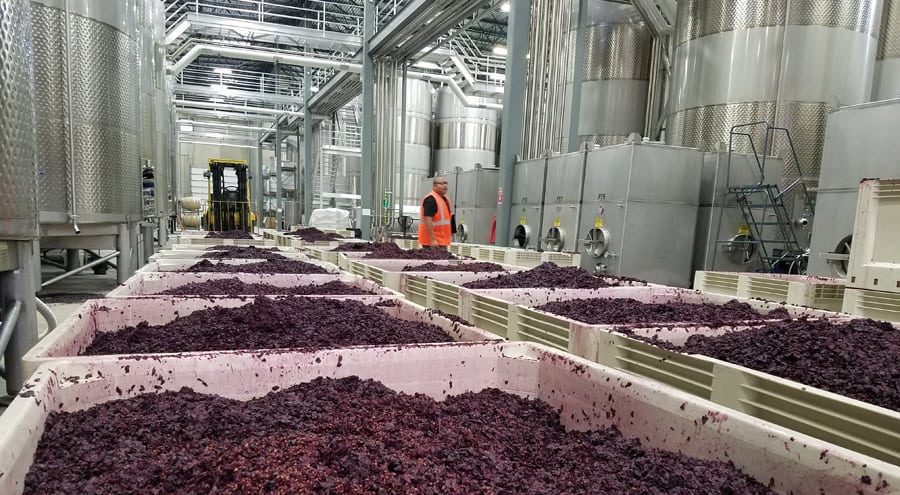
Home » Manufacturing great wine takes good grapes, technology
Manufacturing great wine takes good grapes, technology

June 14, 2018
By David Forsyth
Making a wine is an active process. A winery is a functional factory, like any other production facility. The factors are the raw materials, in this case grapes, and the available technology to blend them.
The process begins with growing the grapes, then harvesting the grapes and crushing or pressing the fruit, fermenting the juice, followed by pressing if a red grape, clarifying, aging and bottling. For each of these steps, there are many decisions that affect the quality of the wine.
 David Forsyth
David ForsythI believe that about 50 percent of the final wine quality and style is defined in the vineyard, 20 percent or so with the picking decision, another 20 percent with the fermentation and red wine management and the final 10 percent is the post fermentation, aging and bottling and continued aging in the bottle. As you can see, the quality and the style of a wine is pretty much fixed just weeks after the grape has arrived at the winery.
So, let’s take a look at the grapes and the vineyard. In the vineyard, there are hundreds of decisions to be made that will affect the flavor and quality of the grapes: location, crop load (tons/acre), amount and frequency of water applied and canopy density (amount of leaves shielding the grapes from sun). These things make up the terroir of a site and managing all of these elements has an impact on the quality of grapes and the style of wine produced.
After the picking decision is made, the grapes will arrive at the winery and they need proper handling. Most vineyards are now mechanically harvested, but there are some vineyards that are handpicked. Mechanically harvesting in the cool of the night is beneficial and is followed by gentle handling of the fruit at the winery to separate the juice from the skins and seed without picking up bitterness and astringency. Rough handling of the grapes releases these undesirable compounds.
Red and white grapes take different paths when arriving at the winery. The red grapes will go through a stemmer/crusher and deliver to the tanks with skins and seeds to begin fermentation to extract color and tannins that give the wine color, structure and body. The white grapes go directly to the press where the juice is immediately pressed away from the skins to minimize the impact of the phenols on the more delicate white wines.
Here arises some decisions, like how hard to press the juice, what yeast to use to ferment, fermentation temperature, percent of solids to leave for fermentation, management of the red wines and more. Post fermentation, there is the aging to consider, tank and barrel aging, when to bottle and how long to hold the wine in the bottle before releasing for sale.
Winemakers have their own protocol on how to produce their style of wine, but with flexibility to improvise and change if the juice calls for this. In these early stages of winemaking is where the most impact on wine quality and style is made.
Overall, the winemaking process is like any other manufacturing process where you need:
- A plan. Define what wine you want to produce in all the details. Variety, alcohol, color, style, price and how you will get the end product. This includes fruit sourcing, fruit ripeness, grape crushing/pressing, fermentation temperature, tank aging or barrel aging (type of barrels and length of time) and when the product will be bottled. Work up the plan with room to modify and tweak during the process to adjust for things that may arise due to vintage – flavor, fermentation rate and color extraction, to name a few. Harvest is a busy time and you want to do as much planning beforehand to free yourself to deal with the changes, issues and duties of harvest.
- A good raw product. This is all about the grapes. Sourcing the appropriate grapes for the wine you are producing. If you are producing a Cabernet Sauvignon for $16 a bottle, you will not be able to afford fruit from a low tonnage vineyard site, but you can maximize the quality by working with the growing and making good growing and picking decisions.
- Good people. Hire good employees. Invest in their training and welfare and they will reward you by being dedicated and responsible and help you take care of the wine.
- Equipment and facilities. Invest in your facility with proper equipment that is appropriate for the work and the right size for facility. The investment, while expensive, will pay for itself in time saved and wine quality. Efficiently handling fruit and wine will free you up to do other tasks that can increase wine quality.
There is no magic to making great wine. It is hard work, with attention to detail, not cutting corners and doing the right thing. There is no greater reward than having someone tell you how much they enjoy a wine that you have made.
David Forsyth is the winemaker and general manager of Four Feathers Wine Estates in Prosser.
Local News Manufacturing
KEYWORDS june 2018





